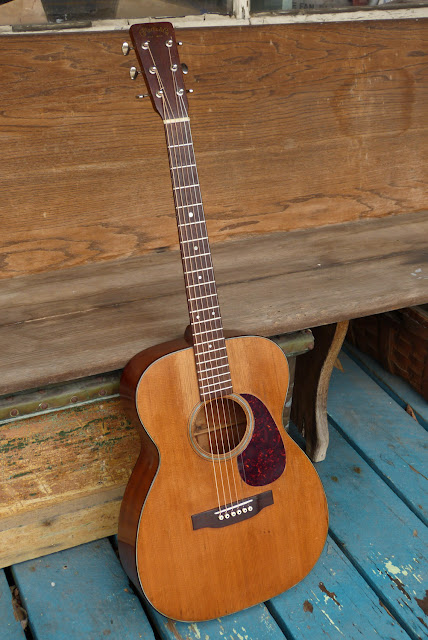1951 Martin 00-18 Flattop Guitar
This Martin is an old dog but what a gorgeous sound! After doing the work on it, I hit an open chord and said, "oh my!" It did not sound like that early-50s Martin tone that I expect (and adore) -- a bit up-front, chunky, and mids-rich like a Gibson -- instead, it was blooming side-to-side with a ton of bass and warmth like a 30s Martin. I checked the bracing inside and, to my surprise, someone had shaved the braces down into the super-light, scalloped shape you'd expect on a 30s box. The job was not aesthetically beautiful but it was competently done -- the top was not deflecting any more than expected after stringing-up and it appears stable and happy.
The guitar, of course, shows plenty of other tinkering, too. The whole thing has been oversprayed with a satin coat that's yielded its own weather-check and crackle in a wide, curious pattern and there are parts of discoloration on the sides and back that suggest minor refinishing, too. I almost wonder if they were worn bare and then covered-up by the overspray judging by the crazy amount of "washboard" wear on the upper-bout. The pickguard is also a replacement and the tuners, pins, nut, and saddle are, too. The bridge is original but was shaved funkily when it came in.
My work included a fret level/dress to solve a terrible level/no-dress job done before, re-shape of the original bridge and mod to a drop-in saddle load, a new bone saddle, cleats and seal jobs for three back cracks and one top crack, cleaning, and general setup. The neck is dead straight and has a modern-ish, 1 11/16" nut width plus shallower C/V hybrid shape. Action is spot-on with 3/32" EA and 1/16" DGBE and strung with 12s (gauges 54w, 40w, 30w, 22w, 16, 12).
Hanging-up in the store, the guitar looks like a grand old player's box -- which it is.
The tuner ferrules on this guitar are original but the tuners themselves are new, Grover Sta-Tites that work oh so well. Thankfully the person who put them on didn't decide on hanging Rotomatics on the thing.
I love the look of the "washboard" pickwear all over the upper bout.
Here's more of that pickwear. There are a few shorter hairline cracks in here that were cleated-up and sealed long ago.
While the bridge is original and Brazilian rosewood like the headstock veneer and fretboard, it was shaved in an odd way when it came in. I badgered the wrecked saddle slot into submission and modified it into a drop-in slot, shaved the entire thing down further to the common height of the leading edge of the bridge, and then filled/redrilled the pinholes for a clean fit.
The end result is something with the height of a 60s/70s Gibson bridge, decent saddle height above the deck, better back-angle on the saddle, a cleaner look, and a tidy underside because of the redrilled pinholes.
Here's how it looked when it arrived. The saddle slot was an arc and really rough, though you can't see it in the photos too well.
Here's my work half-way through.
The usual Style 18 features apply -- solid spruce top, solid mahogany back, sides, and neck, a non-adjustable truss rod in the neck, and simple, classy binding and rosette.
These are the 18:1 ratio Sta-Tites, I believe.
See the wide "crackle" to the finish? That's all over the guitar, more or less, and looks pretty neat. Obviously the overspray was done a while ago.
Here are the three repaired cracks on the rear.
The pins and endpin are all replacements.

























Comments